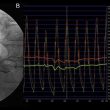The DISCOVER FLOW trial has recently showed an excellent correlation between fractional flow reserve values (FFR) traditionally obtained with coronary CT angiography (CCTA) and the ones obtained with a non invasive technology derived from multi slice computerized tomography (MSCT). Researchers used a novel technology that allows deriving non invasive FFR from MSCT data. Dr. Bon-Kwon...
HeartFlowNXT: Using noninvasive FFR shows promising results
The use of fractional flow reserve (FFR) is useful to determine the significance of coronary lesions. The ability to perform this physiologicalevaluation in a noninvasive base is an interesting alternative.The primary objective of the study was to compare the noninvasive FFRusing multislice CT versus invasive FFR. 357 patients were included in this multicenter study succeeded...
Long Term Outcomes of Hyperemic Stenosis Resistance Index (HSR) in Patients with Stable Chronic Angina
The hyperemic stenosis resistance index (HSR) was introduced as a more complete hemodynamic severity indicator of a coronary lesion. HSR combines both pressure drop across a lesion and the flow through it, therefore overcoming the limitations of traditional indices such as fractional flow reserve (FFR) and coronary flow reserve (CFR). The aim of this multicenter...
EuroPCR 2024 | DOCTORS-LM Trial: CTO Optimizes Stent Outcomes in Left Main Disease?
The aim of this randomized open study was to determine whether CTO guided left main percutaneous coronary intervention (PCI) is superior to fluoroscopy guided PCI, using fractional flow reserve (FFR) after stenting. The secondary outcomes were procedural success (successful implantation, malposition, edge dissection or stent collapse) and major adverse cardiovascular events (MACE) at one year....
EuroPCR 2024 | Influence and Effect of CAD Physiopathological Patterns in the Safety and Efficacy of PCI
Coronary revascularization aims at improving coronary flow. However, after successful percutaneous coronary intervention (PCI) a significant number of patients might experience suboptimal coronary physiology. It has been observed that low fractional flow reserve (FFR) after PCI is associated to poor prognosis. Also, improved FFR after procedure directly correlates with improved angina symptoms. Pullback pressure during...
AHA 2023 | ORBITA-2: PCI vs. Placebo in Stable Angina for Symptom Reduction
In patients with stable chronic angina, percutaneous coronary intervention (PCI) is often conducted to relieve symptoms. However, there is still some uncertainty regarding whether PCI provides superior symptomatic relief compared with a placebo in patients not receiving anti-anginal medication. Researchers conducted a controlled and randomized study in which patients with stable angina discontinued all anti-anginal...
What to Do in Cases of AMI with Multivessel Disease
The presence of lesions in multiple vessels is common in ST-segment elevation myocardial infarction (STEMI). It has been shown that, when they are treated in a second procedure, patients have a better outcome. To date, there is limited information available on percutaneous transluminal coronary angioplasty (PTCA) in vessels with severe non-culprit lesions during primary angioplasty....
We Should Revascularize Patients with Stable Coronary Syndromes and Ischemia Assessed by iFR
Chronic stable angina has shown a good response to medical treatment, and the Ischemia study has recently demonstrated the safety of such treatment in stable chronic angina with moderate to severe ischemia. However, this study excluded left main coronary artery (LMCA) lesions. The FAME Study has shown the safety and efficacy of fractional flow reserve...
Post PCI Functional Assessment for Focal Lesion and Stent Underexpansion Detection
The use of fractional flow reserve (FFR) and non-hyperemic pressure indices (NHPRs) have become essential for intermediate lesion revascularization. A linear inverse correlation has been recently shown between the use of post PCI physiology and cardiovascular events at followup. However, its adoption has been limited so far, seeing the wide variety of algorithms used in...
Coronary Physiology after Aortic Valve Intervention
Impact of Aortic Valve Intervention on Coronary Flow Reserve Myocardial flow might be compromised in patients with severe aortic stenosis, which might be driven by CAD and concomitant atherosclerosis or a compromised capillary bed. Capillary circulation might be compromised by increased left ventricular mass (LVM) which in turn might alter coronary flow reserve (CFR). Multiple...








